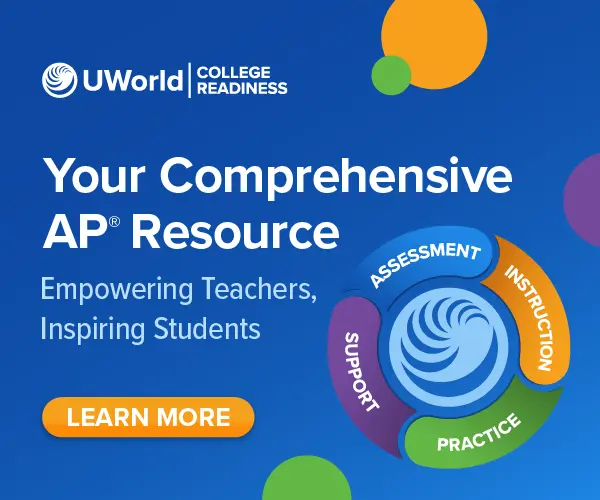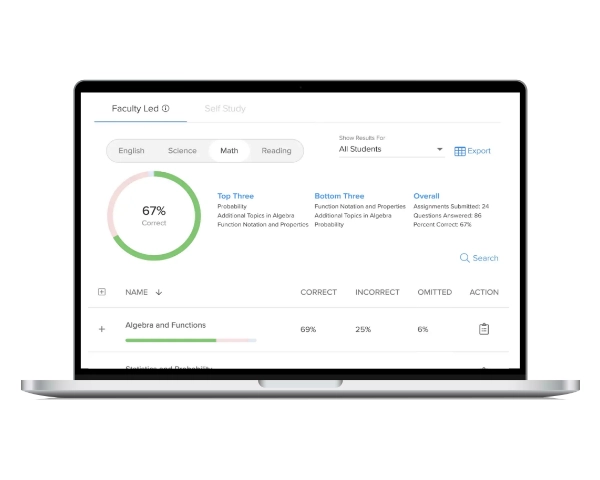A teacher preparing students for Advanced Placement® (AP) exams is much like a parent preparing their teen for a driver’s test. As an AP educator, you teach the skills students need, just as a parent teaches safe driving habits, hoping each learner has what they need to excel.
However, skills alone aren’t enough. To help students get the best results, educators should provide them with a well-equipped vehicle to practice with, powered by the right mix of AP resources, including AP Classroom and UWorld.
How to Use AP Classroom for Teachers: Key Features

AP Classroom is a free resource offered by College Board®. Since it comes with every AP course, it’s worthwhile to learn how to use its features strategically to best support student success.
However, with so many features and tools available, it can be difficult to determine what works best. Based on feedback from teachers and insights from our own AP educators, we’ve highlighted the top 3 features that provide the most consistent value, along with practical tips for using them effectively.

Use 1: AP Progress Checks as the Dashboard
Progress checks in AP Classroom are like a car dashboard, providing metrics and data. They give teachers a reading of students’ performance on specific units or topics. Because the questions are written by the College Board, progress checks provide a snapshot of student performance tied to the exam framework.
How to Use AP Progress Checks
Use at unit milestones:
Assign at the end of a unit or before a review session to measure readiness.
Review results promptly:
Class reports highlight the top 1 or 2 skills students struggled with most, so you can reteach before moving forward.
Instigate peer review:
After a progress check, sort students into small groups based on areas needing improvement.
Stagger assignments:
Give progress checks for different classes at different times to match their pace.
Add a quick reflection:
Ask students to annotate a missed item with “why I chose it” and “what I’ll try next time” to build metacognition.
Optimize completion settings:
Lock/unlock as needed and control when students see items or answers to fit your lesson flow.
The Upgrade? Daily Practice and Engagement
AP progress checks are valuable snapshots, but they only display information — like a dashboard light that tells you something needs attention. The real upgrade allows students to practice with the exact concepts their progress checks flagged.
This is where UWorld adds depth. With pre-made practice sets, ready-to-use presentations, student-centered study guides, and additional learning tools such as flashcards or videos, checkpoints are transformed into hands-on learning experiences. This way, students don’t just see where they stand, but tangibly work with the very skills that need strengthening.
Use 2: AP Classroom Question Bank as the Engine
The AP Classroom question bank functions like the engine of a car; it provides practice material that keeps things running. Educators can select questions by unit or topic to assemble practice sets, quizzes, or short assignments that reflect the structure of the AP exam.
How to Use the AP Classroom Question Bank
Filter by focus:
Target a specific unit/skill when reinforcing recent material.
Keep sets short:
A short 5-to-10-item quiz given periodically can support tight lesson timing.
Mix and shuffle topics:
Combine topics or shuffle question order to mimic test conditions.
Incorporate video refreshers:
Pair practice sets with AP daily videos to reinforce concepts outside of class.
Assign for independent work:
Use it as homework or self-practice, then discuss the answers in class.
Encourage discussion:
Work through one question as a class and ask students to explain their reasoning.
The Upgrade? Student-Friendly Answer Explanations
A strong engine powers the car, but doesn’t explain how the parts work together. Without that deeper understanding, gaps in learning can impact performance, especially under the pressure of AP exams, when a student forgets a detail.
UWorld’s Courses for AP provide the solutions that prevent this. Every practice question comes with detailed answer explanations that define key terms, break down complex concepts step by step, and outline strategies students can use to solve problems. Paired with visuals, authentic examples, and interactive tools, from formula sheets to mini-lessons, UWorld gives students multiple ways to connect with the material and recall it when it matters most.
Use 3: Exam Practice as the Steering Wheel
Practice questions and mock exams in AP Classroom function like the steering wheel of a car. They serve as practice material that reflects the AP exam and keeps students on course.
By assembling multiple-choice (MCQ) and free-response (FRQ) questions from College Board, teachers can create quizzes that mirror the rigor of the AP exam. Such practice offers direction by reflecting the structure of the exam, giving students exposure to its format.
How to Use AP Classroom for Exam Practice
Build short quizzes:
Reinforce pacing and stamina without overwhelming students.
Assign full-length tests:
Simulate the timing and pressure of exam day conditions.
Mix question types:
Combine MCQs and FRQs to reflect the real test format.
Track endurance patterns:
Notice where accuracy or focus drops during longer sets.
Ensure authentic practice:
Since AP Classroom answers are easily found online, highlight the value of skipping shortcuts.
Distribute practice seasonally:
Provide steady exam exposure instead of clustering timed work in the spring.
The Upgrade? Strategies for Building Exam-Day Stamina
A steering wheel keeps a car straight, but doesn’t teach you how to handle sharp turns on your own. The same applies to exam practice. Just because it replicates the test, doesn’t always mean students are prepared for real exam conditions.
UWorld’s comprehensive Courses for AP give students everything they need to prepare for exam day. Timed practice sessions, exposure to common distractor patterns, and strategies for tackling multiple-choice and free-response questions mirror the real pressure of AP exams. With pre-built unit tests and instructional support layered in, practice becomes more than repetition. These tools allow study sessions to transform into training for endurance, decision-making, and independence under exam conditions.
AP Classroom and UWorld: The Best Way Forward
With AP Classroom as a free, accessible resource, and UWorld providing deeper, comprehensive learning features, educators can provide students with a vehicle built to accelerate their learning. Together, these tools create a smoother path toward exam success.
Discover how these resources best work hand in hand in our complete guide on UWorld and AP Classroom. We’d love to connect and support you as you guide the next class of AP drivers.
Frequently Asked Questions (FAQs)
What is AP Classroom, and who is it for?
AP Classroom is College Board’s online platform for AP courses, designed to give educators and students access to official AP-aligned resources such as progress checks, question banks, and instructional videos. It’s used by AP teachers, but can also support tutors, coordinators, and advanced academics staff.
Should teachers use AP Classroom alongside other tools?
Yes. AP Classroom provides official AP‑aligned resources, but combining it with tools such as UWorld empowers educators to help students close learning gaps. Instead of students hunting for outdated answers online, they can work through up-to-date, AP-style questions with clear explanations for incorrect and correct answers.
How do teachers use AP Classroom effectively?
Use topic questions for daily practice, assign progress checks at the end of each unit, and review dashboard data to adjust instruction as needed.
What are the common challenges faced with AP Classroom?
Teachers often mention a complex interface, limited customization, occasional tech issues, and Quizlet sets with AP Classroom answers that are easy for students to find. Pairing AP Classroom with learning tools that offer fresh, digital, AP-style questions helps prevent answer-hunting from replacing actual learning.
What tools are better than AP Classroom for deeper practice?
UWorld is a top choice for building exam‑level mastery with rigorous question sets, in‑depth answer explanations, and performance analytics. Pairing UWorld with AP Classroom ensures alignment to College Board content and true depth of understanding.
What is the difference between AP daily and progress checks?
AP daily videos focus on content delivery and review, while progress checks are unit‑based assessments that measure student understanding and readiness.
Can students retake AP Classroom progress checks?
Typically, no. Progress checks are designed as single‑attempt assessments to capture current readiness accurately.












